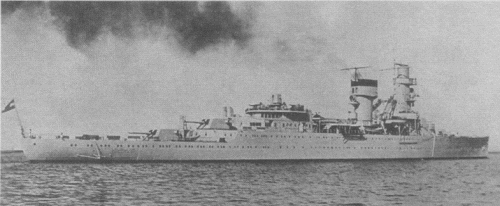
NAVYPEDIA
 Support the project with paypal
Support the project with paypal
Photo

De Ruyter Many thanks to Wolfgang Stöhr for additional information on this page.
Ships
| Name | No | Yard No | Builder | Laid down | Launched | Comp | Fate |
|---|---|---|---|---|---|---|---|
| De Ruyter | 652 | Wilton-Fijenoord, Schiedam | 16.9.1933 | 11.5.1935 | 3.10.1936 | sunk 28.2.1942 |
Technical data
| Displacement standard, t | 6442 |
|---|---|
| Displacement full, t | 7548 |
| Length, m | 168.3 pp 170.8 oa |
| Breadth, m | 15.7 |
| Draught, m | 5.10 |
| No of shafts | 2 |
| Machinery | 2 sets Parsons geared steam turbines, 6 Yarrow boilers |
| Power, h. p. | 66000 |
| Max speed, kts | 32 |
| Fuel, t | oil 1300 |
| Endurance, nm(kts) | 11000(12) |
| Armour, mm | belt: 50 - 30, bulkheads: 30, deck: 30, turrets: 100 - 30, barbettes: 50, CT: 30 |
| Armament | 3 x 2 - 149/50 Bofors/Wilton-Fijenoord No.9, 1 x 1 - 149/50 Bofors/Wilton-Fijenoord No.10, 5 x 2 - 40/56 Bofors No.3, 4 x 2 - 12.7/90, 1 catapult, 2 seaplanes (C.XIW) |
| Complement | 480 |
Standard scale images

De Ruyter 1942

De Ruyter 1941
Graphics
Project history
In 1930, in view of the Japanese naval power excursion, the parliament of the Netherlands has made a decision about building of third cruiser for service in the East Indies. For economy reasons, she should have displacement less, than Java class cruisers, equal protection and 32kts speed. Armament should consist of 6 15cm guns (2 twin mounts aft and 2 single fwd) and 2 twin 105mm AA guns. This decision has undergone to the shattering criticism because of the small dimensions and weak armament. It was offered to finish at an insignificant dimensions enlargement number of guns to 8 150mm or 6 203mm. In 1932 the conciliatory proposal was accepted: at the expense of some hull lengthening and displacement increase seventh main gun has been added. Order has been given out 1.9.1932. It was originally supposed to give to cruiser name Celebes, but at launch she was named De Ruyter, that has caused of renaming of one Admiralen class destroyer.
The design was developed by the German-Dutch consortium "Krupp-Germania/IvS" (Ingeenieurkantoor voor Scheepsbouw) and carried a print of the German effect; in particular, thanking tower-shape superstructure outwardly ship very much resembled Deutschland class armoured ships. At building measures were taken for the maximum weight decrease: framing was realised on longitudinal system, armour belt was a hull structural part, welding and aluminium alloys were widely used.
Fire control system of Hazemeyer included two directors: fore with a 6m rangefinder on fore superstructure and aft with 4m rangefinder. Abandoning from an antiaircraft artillery of secondary calibre became prominent feature of the design: all antiaircraft armament consisted from 5 twin 40mm/56 Bofors No.3 MGs. Each 40mm mount was equipped by own individual Hazemeyer director with ballistic calculator, 2m rangefinder and a collimating sight. Aviation equipment included 18.6m Heinkel K8 catapult and two Fokker С.XIW seaplanes, however the hangar was not available.
The designed capacity of 66000hp ensured to the ship 32kts speed, but 15% overload (to 76000hp) was short-term supposed, that allowed to reach 33.6kts. After major boilers repairs in 1941 De Ruyter has shown on trials 32.84kts. 2 Curtis cruising geared turbines (6600hp) ensured very great endurance at economic speed.
Ship protection
50mm armoured belt (133x4m) protected a hull between end barbettes and was closed by 30mm bulkheads. Ship ends were protected by 30mm belt with 3m height. Flat 30mm deck was connected with upper edge of the belt. Turrets (and also sheet of single gun) had 100mm faces and 30mm protection from other directions.
Modernizations
None.
Naval service
De Ruyter in battle in Java sea 27.2.1942 has received hits of two 203mm shells, and a torpedo hit from Japanese cruiser Haguro and sunk at early o`clock 28.2.1942.
Many thanks to Wolfgang Stöhr for additional information on this page.
 HOME
HOME FIGHTING SHIPS OF THE WORLD
FIGHTING SHIPS OF THE WORLD NETHERLANDS
NETHERLANDS CRUISERS
CRUISERS DE RUYTER light cruiser (1936)
DE RUYTER light cruiser (1936)
